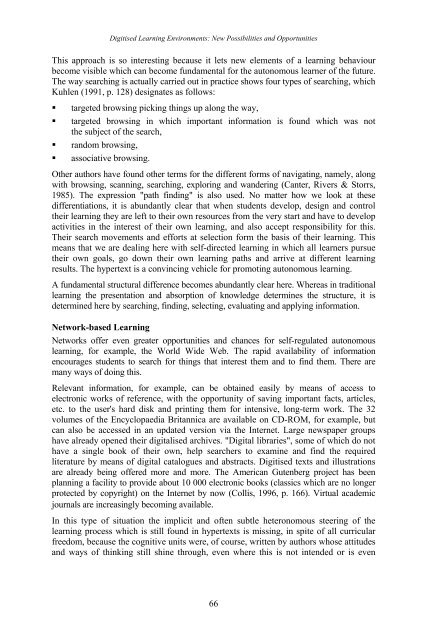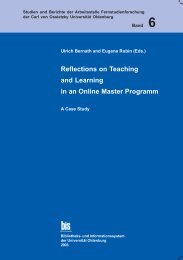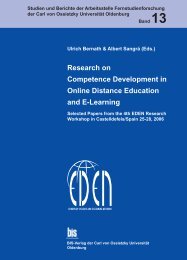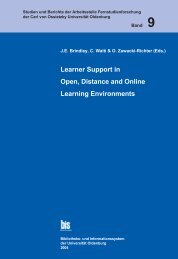Distance Education in Transition - Master of Distance Education ...
Distance Education in Transition - Master of Distance Education ...
Distance Education in Transition - Master of Distance Education ...
Create successful ePaper yourself
Turn your PDF publications into a flip-book with our unique Google optimized e-Paper software.
Digitised Learn<strong>in</strong>g Environments: New Possibilities and Opportunities<br />
This approach is so <strong>in</strong>terest<strong>in</strong>g because it lets new elements <strong>of</strong> a learn<strong>in</strong>g behaviour<br />
become visible which can become fundamental for the autonomous learner <strong>of</strong> the future.<br />
The way search<strong>in</strong>g is actually carried out <strong>in</strong> practice shows four types <strong>of</strong> search<strong>in</strong>g, which<br />
Kuhlen (1991, p. 128) designates as follows:<br />
� targeted brows<strong>in</strong>g pick<strong>in</strong>g th<strong>in</strong>gs up along the way,<br />
� targeted brows<strong>in</strong>g <strong>in</strong> which important <strong>in</strong>formation is found which was not<br />
the subject <strong>of</strong> the search,<br />
� random brows<strong>in</strong>g,<br />
� associative brows<strong>in</strong>g.<br />
Other authors have found other terms for the different forms <strong>of</strong> navigat<strong>in</strong>g, namely, along<br />
with brows<strong>in</strong>g, scann<strong>in</strong>g, search<strong>in</strong>g, explor<strong>in</strong>g and wander<strong>in</strong>g (Canter, Rivers & Storrs,<br />
1985). The expression "path f<strong>in</strong>d<strong>in</strong>g" is also used. No matter how we look at these<br />
differentiations, it is abundantly clear that when students develop, design and control<br />
their learn<strong>in</strong>g they are left to their own resources from the very start and have to develop<br />
activities <strong>in</strong> the <strong>in</strong>terest <strong>of</strong> their own learn<strong>in</strong>g, and also accept responsibility for this.<br />
Their search movements and efforts at selection form the basis <strong>of</strong> their learn<strong>in</strong>g. This<br />
means that we are deal<strong>in</strong>g here with self-directed learn<strong>in</strong>g <strong>in</strong> which all learners pursue<br />
their own goals, go down their own learn<strong>in</strong>g paths and arrive at different learn<strong>in</strong>g<br />
results. The hypertext is a conv<strong>in</strong>c<strong>in</strong>g vehicle for promot<strong>in</strong>g autonomous learn<strong>in</strong>g.<br />
A fundamental structural difference becomes abundantly clear here. Whereas <strong>in</strong> traditional<br />
learn<strong>in</strong>g the presentation and absorption <strong>of</strong> knowledge determ<strong>in</strong>es the structure, it is<br />
determ<strong>in</strong>ed here by search<strong>in</strong>g, f<strong>in</strong>d<strong>in</strong>g, select<strong>in</strong>g, evaluat<strong>in</strong>g and apply<strong>in</strong>g <strong>in</strong>formation.<br />
Network-based Learn<strong>in</strong>g<br />
Networks <strong>of</strong>fer even greater opportunities and chances for self-regulated autonomous<br />
learn<strong>in</strong>g, for example, the World Wide Web. The rapid availability <strong>of</strong> <strong>in</strong>formation<br />
encourages students to search for th<strong>in</strong>gs that <strong>in</strong>terest them and to f<strong>in</strong>d them. There are<br />
many ways <strong>of</strong> do<strong>in</strong>g this.<br />
Relevant <strong>in</strong>formation, for example, can be obta<strong>in</strong>ed easily by means <strong>of</strong> access to<br />
electronic works <strong>of</strong> reference, with the opportunity <strong>of</strong> sav<strong>in</strong>g important facts, articles,<br />
etc. to the user's hard disk and pr<strong>in</strong>t<strong>in</strong>g them for <strong>in</strong>tensive, long-term work. The 32<br />
volumes <strong>of</strong> the Encyclopaedia Britannica are available on CD-ROM, for example, but<br />
can also be accessed <strong>in</strong> an updated version via the Internet. Large newspaper groups<br />
have already opened their digitalised archives. "Digital libraries", some <strong>of</strong> which do not<br />
have a s<strong>in</strong>gle book <strong>of</strong> their own, help searchers to exam<strong>in</strong>e and f<strong>in</strong>d the required<br />
literature by means <strong>of</strong> digital catalogues and abstracts. Digitised texts and illustrations<br />
are already be<strong>in</strong>g <strong>of</strong>fered more and more. The American Gutenberg project has been<br />
plann<strong>in</strong>g a facility to provide about 10 000 electronic books (classics which are no longer<br />
protected by copyright) on the Internet by now (Collis, 1996, p. 166). Virtual academic<br />
journals are <strong>in</strong>creas<strong>in</strong>gly becom<strong>in</strong>g available.<br />
In this type <strong>of</strong> situation the implicit and <strong>of</strong>ten subtle heteronomous steer<strong>in</strong>g <strong>of</strong> the<br />
learn<strong>in</strong>g process which is still found <strong>in</strong> hypertexts is miss<strong>in</strong>g, <strong>in</strong> spite <strong>of</strong> all curricular<br />
freedom, because the cognitive units were, <strong>of</strong> course, written by authors whose attitudes<br />
and ways <strong>of</strong> th<strong>in</strong>k<strong>in</strong>g still sh<strong>in</strong>e through, even where this is not <strong>in</strong>tended or is even<br />
66





